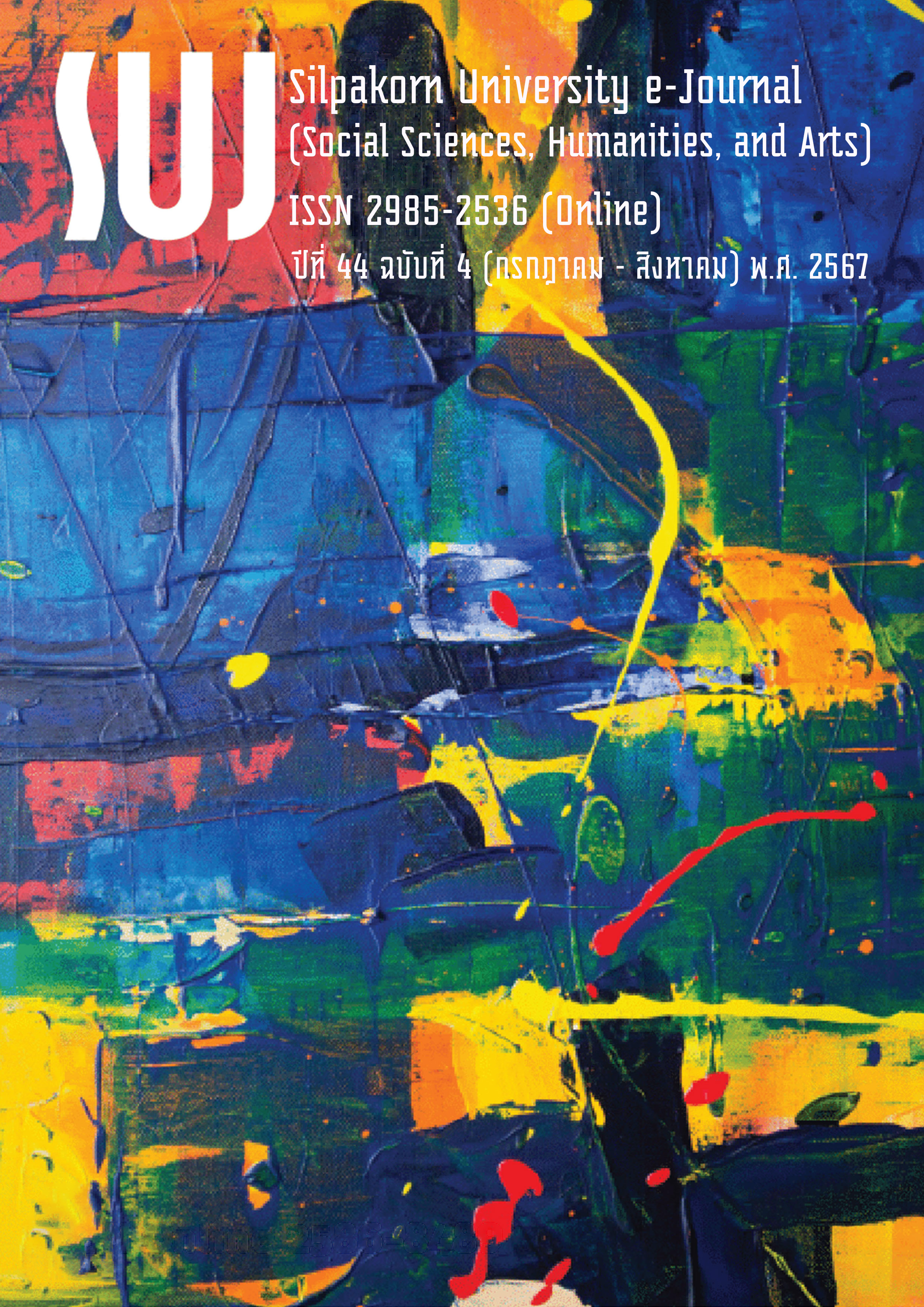การเลือกใช้คำศัพท์เพื่อสื่อหน้าที่สำหรับการแสดงความคิดเห็นของผู้บริโภควาทกรรมเกี่ยวกับการบริจาค (The lexical choices used to convey consumers’ opinions in discourse about donations)
Main Article Content
Abstract
วาทกรรมการบริจาคที่ผลิตและเผยแพร่โดยยูทูบเบอร์ในสื่อใหม่ เป็นวาทกรรมที่ผู้บริโภควาทกรรมให้ความสนใจเนื่องจากเชื่อว่าการบริจาคจะสามารถทำให้ผู้รับบริจาคที่ยากลำบากมีชีวิตที่ดีขึ้น อย่างไรก็ตาม ผู้บริโภควาทกรรมมีทั้งยอมรับและปฏิเสธพฤติกรรมและการกระทำของยูทูบเบอร์ รวมไปถึงการวิพากษ์วิจารณ์การทำงานของรัฐ ความสำคัญข้างต้นจึงทำให้ผู้วิจัยสนใจวิเคราะห์การเลือกใช้คำศัพท์เพื่อสื่อหน้าที่สำหรับการแสดงความคิดเห็นของผู้บริโภควาทกรรมเกี่ยวกับการบริจาค โดยผู้วิจัยเก็บข้อความการแสดงความคิดเห็นภายใต้วีดิทัศน์ของช่องยูทูบพิมรี่พาย จำนวน 82 วีดิทัศน์ และคัดเลือกข้อความแสดงความคิดเห็น 50 ความคิดเห็นแรกของแต่ละวีดิทัศน์ รวมทั้งสิ้น 4,100 ข้อความ ผลการวิจัยชี้ให้เห็นว่าผู้บริโภควาทกรรมมีการเลือกใช้คำศัพท์ในการแสดงความคิดเห็นเกี่ยวกับวาทกรรมการบริจาค 5 ประการ ได้แก่ การเลือกใช้คำศัพท์ในการแสดงความคิดเห็นที่มีต่อยูทูบเบอร์ การเลือกใช้คำศัพท์ในการแสดงความคิดเห็นที่มีต่อผู้รับบริจาค การเลือกใช้คำศัพท์ในการแสดงความคิดเห็นที่มีต่อตนเอง การเลือกใช้คำศัพท์ในการแสดงความคิดเห็นที่มีต่อหน่วยงานรัฐ และการเลือกใช้คำศัพท์ในการแสดงความคิดเห็นที่มีต่อเรื่องอื่น ๆ ซึ่งสื่อให้เห็นหน้าที่ของการสื่อสาร 6 ประการ ได้แก่ กระตุ้นให้ผู้อื่นเกิดอารมณ์ความรู้สึกร่วม วิพากษ์วิจารณ์การทำงานของรัฐ บ่งชี้การสนับสนุนยูทูบเบอร์และผู้รับบริจาค สร้างบุคคลต้นแบบที่พึงปรารถนา อ้างถึงแนวทางการปฏิบัติตนที่เหมาะสม และขอความช่วยเหลือจากยูทูบเบอร์ ผลการวิจัยครั้งนี้จะช่วยเผยให้เห็นทั้งการยอมรับและการปฏิเสธวาทกรรมของผู้บริโภควาทกรรมเกี่ยวกับการบริจาค ในขณะเดียวกันยังสามารถเป็นแนวทางในการสื่อชุดความคิดและอุดมการณ์ตามแนวทางวาทกรรมวิเคราะห์เชิงวิพากษ์ต่อไป
The donation discourse produced and distributed by YouTubers in new media is a discourse that attracts the interest of consumers. This is because they believe that donations can improve the lives of those in difficult situations. However, consumers’ discourse both accepts and resists the behavior and actions of YouTubers, including criticism of government work. The importance of this topic has led the researcher to analyze the lexical choices used to convey the function of expressing consumers’ opinions in donation-related discourse. The researcher collected comment messages from 82 videos on the Pimrypie YouTube channel and selected the first 50 comments from each video, totaling 4,100 messages. The research results indicate that consumer discourse employs five specific lexical choices when expressing opinions about donation discourse: choices related to YouTubers, recipients, oneself, government agencies, and other miscellaneous topics. These lexical choices reflect six communication functions: encouraging others to share emotions, criticizing the work of the state, indicating support for YouTubers and donors, creating desirable role models, referring to guidelines for appropriate behavior, and asking for help from YouTubers. The results of this research reveal both acceptance and resistance in consumer discourse regarding donations. Additionally, these findings can be used to interpret a set of ideas and ideologies through the lens of critical discourse analysis.
Downloads
Article Details

This work is licensed under a Creative Commons Attribution-NonCommercial-NoDerivatives 4.0 International License.
References
Angkapanichkit, Jantima. (2018). Discourse Analysis (การวิเคราะห์ข้อความ) (2nd ed.). Bangkok: Thammasat University Press.
Arunruwiwat, Kwanthip, Phatthanasutinon, Thammawat, Pimthai, Suradech, Rattanadilok Na Phuket, Wipada, & Kaewjungate, Wuttinun. (2021). The linguistic strategies for reprimanding on Twitter application: Case study of an actress’s and a male singer’s love issue (กลวิธีทางภาษาที่ใช้บริภาษในแอปพลิเคชันทวิตเตอร์: กรณีศึกษาประเด็นปัญหาความรักของนักแสดงหญิงและนักร้องชาย). Journal of Humanities, Naresuan University, 18(2): 103-120.
Bunnag, Orawee. (2016). Impoliteness strategies for interviewing celebrities by alternative television channel hosts (กลวิธีความไม่สุภาพในการสัมภาษณ์บุคคลในกระแสของพิธีกรช่องโทรทัศน์ทางเลือกใหม่). Chophayom Journal, 27(2): 13-24.
Bunnag, Orawee. (2019). Linguistic Strategies Adopted for the Construction of Business Organization Image During Crisis Through Organization’s Facebook Page (กลวิธีทางภาษาในการประกอบสร้างภาพลักษณ์องค์กรธุรกิจในภาวะวิกฤตผ่านเฟซบุ๊กองค์กร). Doctoral dissertation, Silpakorn University, Nakhon Pathom, Thailand.
Chapimon, Kuntika. (2021). The Discourse of Monetary Donation Request in Thai Social Media: A Critical Discourse Analysis (วาทกรรมการขอรับบริจาคเงินในสื่อสังคมของไทย: การศึกษาตามแนววาทกรรมวิเคราะห์เชิงวิพากษ์). Doctoral dissertation, Chulalongkorn University, Bangkok, Thailand.
Fairclough, N. (1992). Discourse and Social Change. Cambridge: Polity Press.
Janevatchararuk, Thythavat. (2021). Nonverbal languages of the pitifulness: The attitudes of 3 generations regarding pitifulness toward the nonverbal communication of the Beggars in Bangkok (อวจนภาษาแห่งความน่าสงสาร: ทัศนคติความรู้สึกน่าสงสารต่อการสื่อสารผ่านอวจนภาษาของขอทานในเขตกรุงเทพมหานครของกลุ่มคนใน 3 ช่วงวัย). Chiang Mai University Journal of Humanities, 22(3):161-187.
Kavilanan, Siravast. (2021). The verbal irony used for comment on Facebook in the case of love triangle news in the entertainment industry and cyberbullying: A pragmatics study (ถ้อยคำนัยผกผันที่ใช้แสดงความคิดเห็นผ่านเฟซบุ๊กกรณีข่าวรักสามเส้าในวงการบันเทิงกับการระรานทางไซเบอร์: การศึกษาตามแนววัจนปฏิบัติศาสตร์). Journal of Humanities, Naresuan University, 18(1): 103-116.
Kavilanan, Siravast. (2022). Communicative elements and linguistic strategies for commenting on depression pages: A discourse analysis and pragmatics approach (องค์ประกอบการสื่อสารและกลวิธีทางภาษาเพื่อแสดงความคิดเห็นในเพจโรคซึมเศร้า: การศึกษาตามแนวปริจเฉทวิเคราะห์และวัจนปฏิบัติศาสตร์). Journal of Liberal Arts, Maejo University, 10(1): 224-247.
Khongphianthum, Chanchai. (2019). The political roles of democratic Kampuchea songs (หน้าที่ทางการเมืองของเพลงในสมัยกัมพูชาประชาธิปไตย). HUSO Journal of Humanities and Social Sciences, 3(1): 114-135.
Kolasa, B. J. (1969). Introduction to Behavioral Science for Business. NY: John Wiley & Sons.
Nunnally, J. C. (1959). Test and Measurements: Assessment and Prediction. NY: McGraw Hill.
Onketphon, Kantida, & Khumkhiam, Alisa. (2022). Linguistic devices used for expressing opinions in online novels on the “readAwrite” website (กลวิธีทางภาษาในการแสดงความคิดเห็นที่มีต่อนวนิยายออนไลน์ในเว็บไซต์ “readAwrite”). Inthaninthaksin Journal, 17(1): 175-194.
Panpothong, Natthaporn. (2006). A Study of “Cattleya Jaja” from Linguists: A Content and Linguistics Devices (มองคัทลียาจ๊ะจ๋า จากมุมมองนักภาษา: เนื้อหาและกลวิธี). Bangkok: Academic Publication Program, Faculty of Arts, Chulalongkorn University.
Pornsakulvanich, Vikanda. (2017). New Media and Communications Management (สื่อใหม่และการจัดการการสื่อสาร) (3rd ed.). Bangkok: Thammasat University Press.
Sangthong, Ingfah, & Kuprasert, Titipa. (2023). The language usage and the bad women and men representation in Phut-talk-Phut-tho program (กลวิธีทางภาษากับการนำเสนอภาพ “หญิงร้ายชายเลว” ในรายการพุธทอล์คพุธโทร). Journal of Humanities, Naresuan University, 20(2): 47-76.
Suriya, Thirayut. (2017). The Relationship Between Linguistic Devices and Representations of Rohingyas in Thai Online Media: A Critical Discourse Analysis (ความสัมพันธ์ระหว่างกลวิธีทางภาษากับภาพตัวแทนของชาวโรฮิงญาในสื่อออนไลน์ภาษาไทย: การศึกษาตามแนววาทกรรมวิเคราะห์เชิงวิพากษ์). Doctoral dissertation, Chulalongkorn University, Bangkok, Thailand.
van Dijk, T. A. (1977). Text and Context: Exploration in the Semantics and Pragmatics of Discourse. London: Longman.


